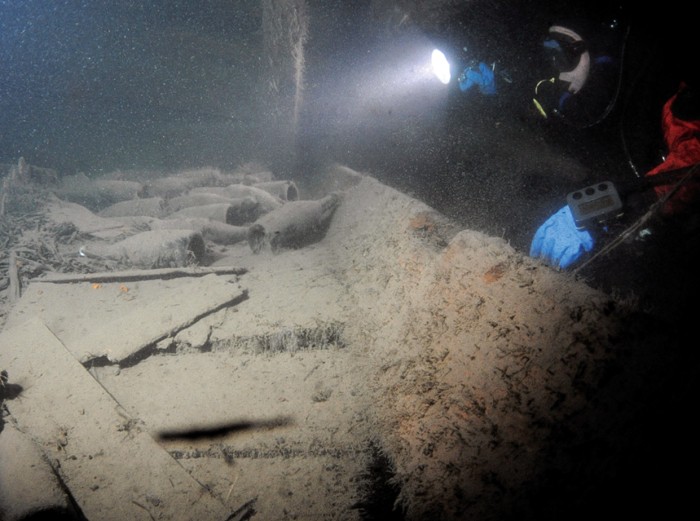Advertisement
Grab your lab coat. Let's get started
Welcome!
Welcome!
Create an account below to get 6 C&EN articles per month, receive newsletters and more - all free.
It seems this is your first time logging in online. Please enter the following information to continue.
As an ACS member you automatically get access to this site. All we need is few more details to create your reading experience.
Not you? Sign in with a different account.
Not you? Sign in with a different account.
ERROR 1
ERROR 1
ERROR 2
ERROR 2
ERROR 2
ERROR 2
ERROR 2
Password and Confirm password must match.
If you have an ACS member number, please enter it here so we can link this account to your membership. (optional)
ERROR 2
ACS values your privacy. By submitting your information, you are gaining access to C&EN and subscribing to our weekly newsletter. We use the information you provide to make your reading experience better, and we will never sell your data to third party members.
Environment
170-Year-Old Champagne Cache Analyzed
Chemical analysis of shipwrecked bubbly reveals secrets of 19th-century French winemaking
by Sarah Everts
May 4, 2015
| A version of this story appeared in
Volume 93, Issue 18

A 170-year-old stash of perfectly preserved champagne taken from a shipwreck off the coast of Finland has brought to light an array of curious facts about past winemaking practices. Chemical analysis of the vintage sparkling wine revealed particularly high levels of sugar and salt compared with modern-day champagne, as well as the presence of unexpected metals, likely introduced by 19th-century wine preservation and storage methods (Proc. Natl. Acad. Sci. USA 2015, DOI: 10.1073/pnas.1500783112).
The champagne also tasted “fabulous, with hints of tobacco,” says Philippe Jeandet, a champagne chemistry expert at the University of Reims Champagne-Ardenne, in France, who led the team of researchers, and who sampled 100 µL of the golden liquid. That drop of vintage champagne “was probably one of the best wines I’ve tasted in my life,” he says.

Jeandet isn’t the only person to have sampled the shipwrecked bubbly. In 2010, divers who discovered the 168 bottles in the cool, dark—and preservative—waters of the Baltic Sea popped a cork when they hit dry land and realized they were most likely drinking century-old champagne, Jeandet notes. Although the bottles no longer had labels, the corks were engraved with the name of a French champagne house, Veuve Clicquot Ponsardin.
Because Veuve Clicquot Ponsardin has been in operation since 1772, the researchers were able to compare the 170-year-old champagne with modern incarnations from the champagne maker. The discovery, and consequent chemical analysis on three of the shipwrecked bottles, was an “unequaled opportunity in ferreting out aspects of the evolution of sparkling wine production that’s been unavailable in the written record,” says Ronald S. Jackson, a wine science scholar at Brock University, in Ontario.
One of the most interesting aspects of the recovered champagne is that the sugar levels are “spectacularly high—higher than most dessert wines produced today,” let alone champagne, comments Andrew L. Waterhouse, a wine scientist at the University of California, Davis. Current champagne comes in two main styles: “very dry,” which contains little residual sugar, and an even drier “brut.” Both contain two orders of magnitude less sugar then than the shipwrecked champagne. “The idea of making champagne with so much sugar” today, Waterhouse says—“a winemaker would just laugh at you.”
In fact, the levels of sugar measured in the ancient champagne were higher than those found naturally in grape juice. This finding suggests that winemakers in the 19th century probably boosted levels artificially. Jeandet and his team believe that these winemakers did so with concentrated grape juice sugar instead of cane sugar, which was also available then. The researchers came to this conclusion because they detected furfural derivatives in the ancient champagne, which are produced during the Maillard reaction as grape juice is slowly heated.

Initially, the team of scientists thought that the ship ferrying the champagne must have been en route to Russia, where there was a predilection for sweet wine. But according to historical documents, the nearly 150 g/L of sugar in the shipwrecked champagne corresponds to German and French sweetness preferences of that era. Russians of the 19th century wanted even sweeter wine: vino that contained 30% sugar, a whopping 300 g/L, Waterhouse says.
Jeandet and his group also discovered three orders of magnitude more salt in the preserved bottles than in modern vintages. At first the team suspected that there must be some seawater contamination, Jeandet says. But the researchers ruled out this possibility by comparing the ratio of bromine and chloride ions in the bubbly with ratios of those ions found in the Baltic Sea.
Instead, the salt was probably added by the champagne producer, albeit not intentionally. Champagne makers used to add gelatin to keep wine from going cloudy, Jeandet says, and salt was added to the gelatin to keep it stable. Today, gelatin is used as a clarifying agent, but the substance is now much purer and, thus, less salty, Waterhouse says.
The shipwrecked champagne also contained unusually high levels of iron, lead, copper, and arsenic compared with modern vintages. Arsenic and copper sulfate found in the century-old fizz likely originated from antiquated pesticides used to kill fungus. Meanwhile the iron and lead probably came from storage containers.
If the idea of aging wine underwater sounds like the basis for a new industry, regulators in the U.S. don’t agree. In March, the Alcohol & Tobacco Tax & Trade Bureau issued a warning about the niche industry of ocean-aging, called “aquaoir.” The regulatory body worries that the industry’s wares may be adulterated or contaminated by seawater pollutants, such as gasoline, heavy metals, drug residues, pesticides, and effluent from sewage treatment plants. Aquaoir enthusiasts will certainly point to this champagne’s successful 170-year storage in rebuttal.





Join the conversation
Contact the reporter
Submit a Letter to the Editor for publication
Engage with us on Twitter